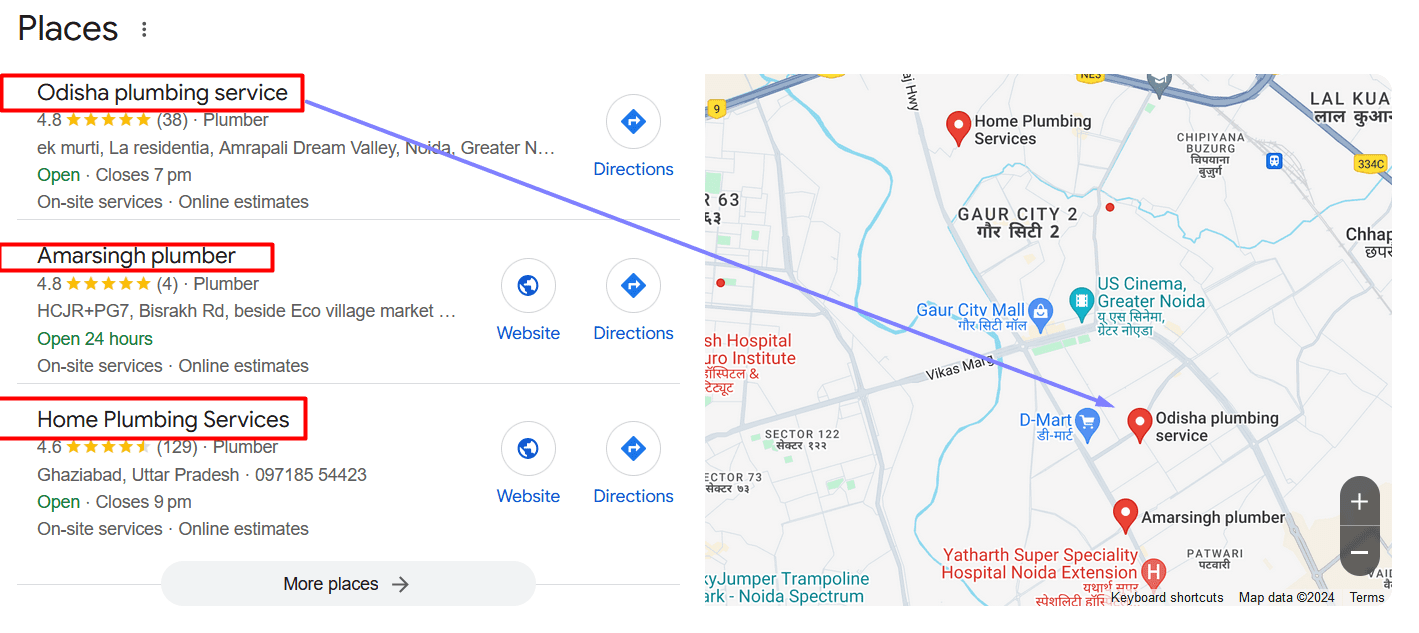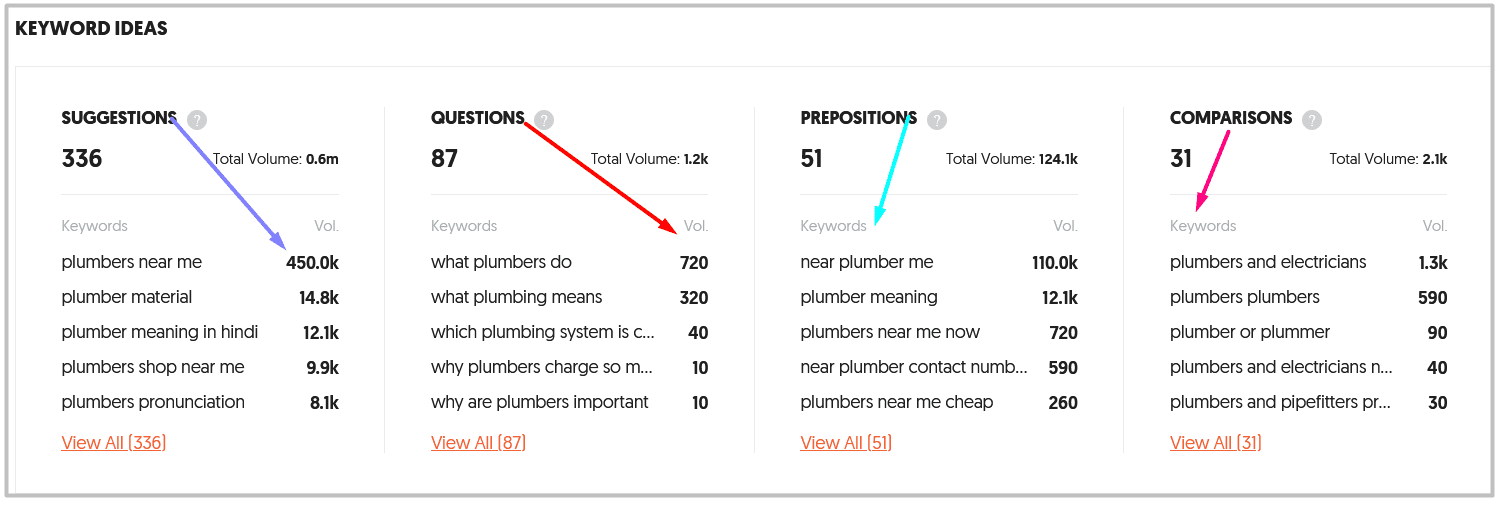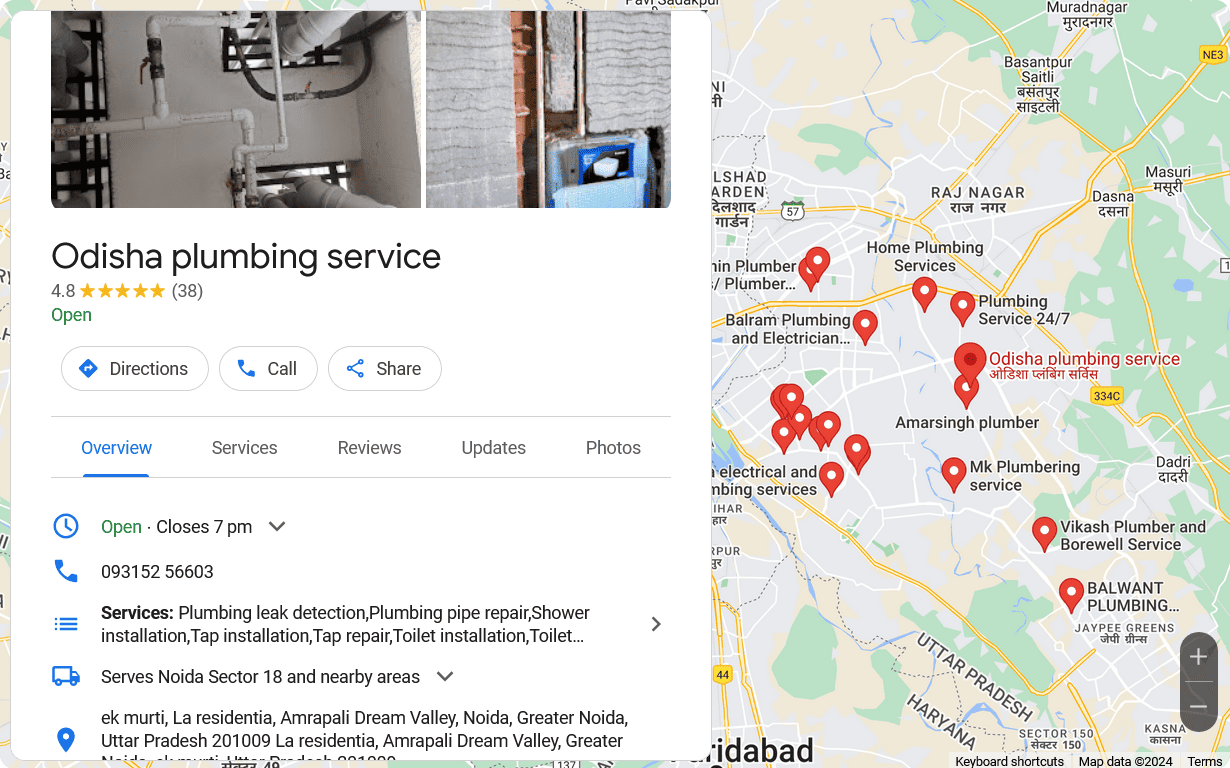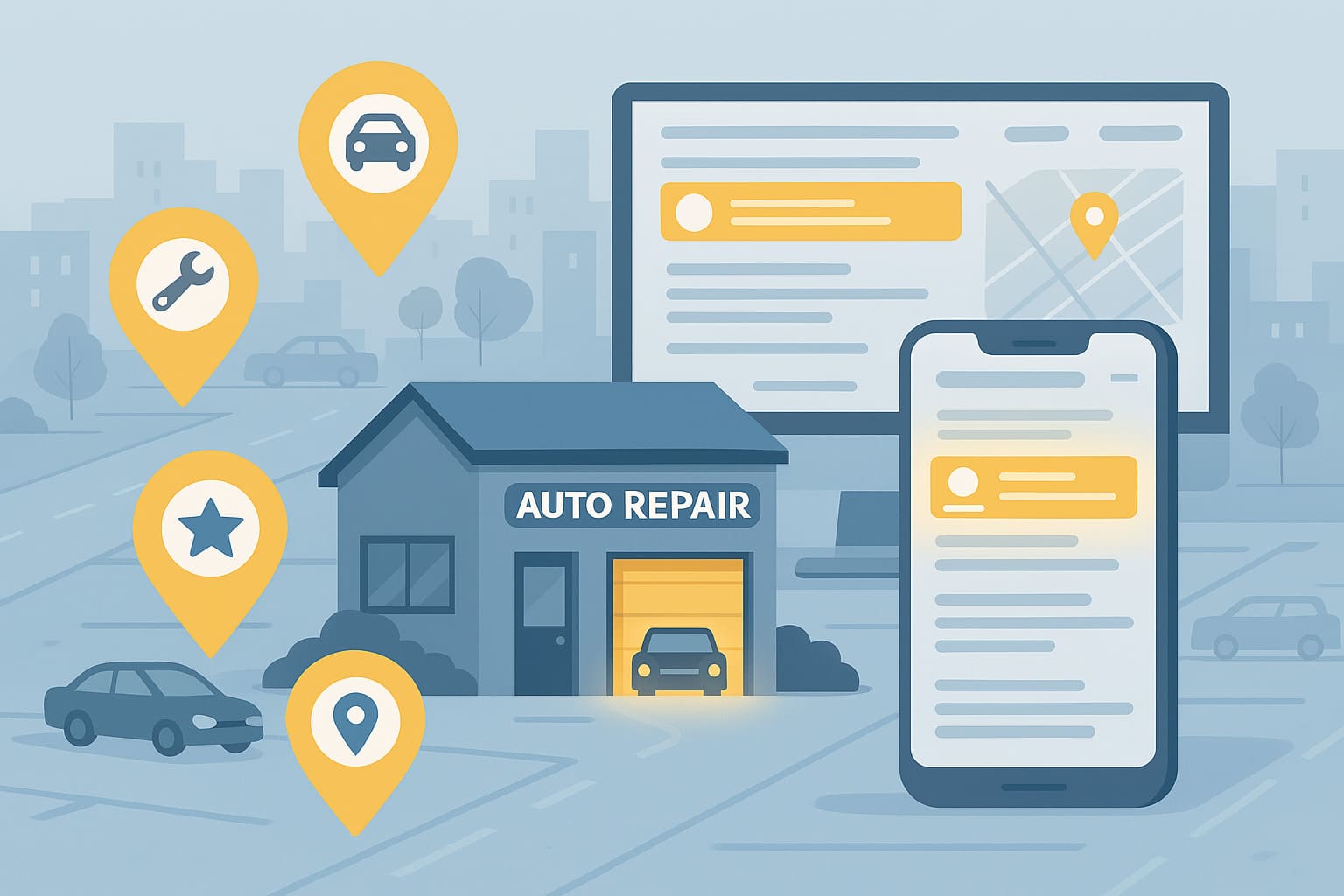
A plumber SEO company can help identify relevant keywords and create targeted content that addresses potential customers’ needs. This drives qualified traffic to your website, helping you stand out in the competitive plumbing industry and leading to more leads and conversions.
Every month, there are over 70,0000+ searches for “plumbers near me” on Google a month. Additionally, terms like “plumbing services” and “24-hours emergency plumber” see tens of thousands of searches monthly, indicating the urgent need for plumbing services.
Plumber SEO services play a crucial role in enhancing online visibility and attracting qualified leads through various SEO strategies tailored specifically for plumbers.
According to ConsumerAffairs, the plumbing industry generates $126.4 billion revenue in 2023, driven by both residential and commercial demands. This guide will show you how to rank higher your plumbing business on search engines like: Google, Bing, Yahoo, from start to finish.
What is SEO for Plumbers?
Plumber SEO, or plumbing SEO, focuses on improving your plumbing website’s search engine ranking to attract more organic traffic and convert visitors into customers. By optimizing your website, you ensure that potential clients can easily find your services when searching for plumbing solutions in their area. Effective SEO strategies tailored for plumbing companies can drive more leads and improve online visibility, ensuring they rank highly in search results and connect with potential customers searching for plumbing services.
The plumbing industry includes various services, such as:
- Residential Plumbing Services
- Commercial Plumbing Contractors
- Emergency Plumbing Services
- Drain Cleaning and Repair
- Pipe Installation and Repair
- Water Heater Services
- Gas Line Services
- Sewer Line Services

No matter what specific plumbing services you offer, SEO can help your website rank higher on search engines like Google. By targeting relevant keywords, such as “emergency plumber” or “water heater repair,” you can drive more targeted traffic to your site and increase leads. Additionally, optimizing a plumbing company’s website through the creation of industry-related content that attracts backlinks is crucial. Regularly updated and high-quality content can enhance a plumbing business’s visibility on search engines, improving search rankings.

Why Do Plumbers Need SEO?
SEO is crucial for plumbers because it ensures that your business is visible to people searching for plumbing services online. In today’s digital age, most customers turn to search engines like Google to find local plumbers. Without SEO, your business might not appear in these searches, which means you could miss out on valuable leads. Partnering with a plumbing SEO company can significantly improve your search engine rankings and online visibility, ensuring that your business is easily found by potential customers.
Key Benefits of SEO for Plumbers:
- Increased Visibility: Most users never scroll past the first page of search results. If your plumbing business isn’t listed on the first page, you’re likely missing out on potential customers.
- Cost-Effective Marketing: Compared to paid ads, SEO offers a more sustainable way to generate leads. Once your site is optimized, it can continuously attract traffic without ongoing costs.
- Targeted Traffic: SEO targets people actively searching for plumbing services, making it more likely that they will convert into paying customers.
- Building Trust and Credibility: A strong online presence with good reviews helps build trust with potential customers. In a service industry like plumbing, trust is crucial.
Investing in plumbing SEO services tailored to the industry can provide specialized strategies that enhance your online presence and drive business growth.
In the competitive plumbing industry, SEO is not just a marketing option—it’s a necessity. By optimizing your website, you can ensure that your business stands out, attracts more leads, and converts those leads into loyal customers.
SEO is not something you do anymore. It’s what happens when you do everything else right.”Chad Pollitt.

10 SEO Tips for Plumbers
Ready to boost your plumbing company online visibility? Here are 11 essential SEO tips for plumbers to help you rank higher, attract more local customers, and convert website visitors into paying clients. These SEO strategies cover everything from optimizing your content to local SEO, ensuring your plumbing company stand out in a competitive market.

1. User Intent and Keyword Research
Understanding user intent and conducting thorough keyword research are the foundation of a successful SEO campaign for plumbers. By identifying what potential customers are searching for, you can optimize your website to meet their needs and attract more relevant traffic.
Why User Intent Matters:
When someone searches for a plumber, their intent can vary significantly. Some may need immediate assistance with keywords like “emergency plumber near me,” while others might be looking for specific services such as “drain cleaning” or “boiler repair.”
Aligning your content with these different intents ensures that your website appears in front of the right audience at the right time.
Steps to Effective Keyword Research:
Step 1. Identify Service Keywords:
Start by listing all the plumbing services your business offers, such as:
- Drain cleaning
- Boiler repair
- Pipe installation
Consider the common problems your customers face and the services they are likely to search for. This list will serve as the foundation for your keyword research.
Step 2. Use Keyword Tools
Utilize tools like Ahrefs’ Keywords Explorer to find variations of your service keywords, especially those that include local modifiers like “near me.” This helps target customers within your service area who are looking for specific plumbing solutions.
For example, searches like “gas boiler repair near me” or “emergency plumber near me” are highly relevant and can drive qualified traffic to your site.
Step 3. Evaluate Keyword Popularity
Not all services are searched for equally. Prioritize creating content for services with higher search volumes. This focus ensures that you address the most popular searches, maximizing your chances of attracting traffic to your site.
Step 4. Assign Keywords to Pages
After identifying your keywords, strategically assign them to specific pages on your website. For example, if you offer multiple drain-related services, you might group similar keywords on one page to avoid redundancy.
A single page optimized for “drain cleaning near me” could cover related searches like “drain unblocking near me” and “drain clearance near me.”

2. Content Creation
Creating high-quality content is essential for any plumber looking to succeed in SEO. A plumber SEO company can help by identifying relevant keywords and creating targeted content that addresses the needs of potential customers. Content creation isn’t just about filling your website with text—it’s about crafting pages that serve specific purposes and address the needs of your potential customers. Here’s how you can approach content creation effectively:
Step 1. Create Service Pages
Each service you offer should have its own dedicated page. This allows you to target specific keywords and provide detailed information about the services you provide.
If you offer “Drain Cleaning” as a service, create a page specifically for that service. The page should detail what drain cleaning entails, the benefits of regular maintenance, and why your service is the best choice.
Focus on:
- Clarity: Clearly explain how each service solves common plumbing problems.
- Catchment: Include maps and service areas to help visitors determine if you serve their location.
- Confidence: Use customer reviews, accreditation, and unique selling points to build trust.
- Contact: Make it easy for visitors to reach out with prominent contact details.
Step 2. Create About Page
Your “About” page is an opportunity to establish E-E-A-T (Experience, Expertise, Authoritativeness, and Trustworthiness). This is crucial for building trust with potential customers, even if it’s not a direct ranking factor.
Include:
- Your business’s history and experience.
- Certifications, licenses, and insurance details.
- Testimonials and reviews from satisfied customers.
- Team members list with photo and little biography
Step 3. Create Location Pages
If you have multiple service areas, create a page titled “Plumbing Services in [City Name].” On this page, list the specific services available in that city, provide customer reviews from that area, and include a Google Map showing your service locations.
Localized content helps you rank in specific geographic areas, increasing the likelihood that customers in those areas will find and choose your services.
Step 4. Use Keywords Naturally
Integrate your target keywords into your content in a natural, reader-friendly way. Avoid keyword stuffing, which can lead to penalties from search engines.
For a page about “Emergency Plumbing Services,” include keywords like “emergency plumber near me” and “24/7 plumbing services” naturally within the text, headings, and meta descriptions.
For example, you could say, “If you’re facing a plumbing emergency, our 24/7 plumbing services are here to help. Contact an emergency plumber near you today.”
Proper keyword placement helps search engines associate your content with specific search queries, improving your chances of ranking well.
Step 5. Diversify Content Types
Don’t limit yourself to written content. Create a video tutorial on “How to Unclog a Drain Safely.” Include a transcript of the video on the page to enhance accessibility and SEO.
Advice:
In addition to videos, regularly update your blog with practical tips and solutions. For example, pair your video tutorial with a blog post titled “Step-by-Step Guide to Unclogging Drains,” offering both visual and written instructions.
Ask The Expert:
Introduce an “Ask the Expert” section on your website where users can submit plumbing-related questions. Respond to these queries through blog posts or short video clips, providing authoritative answers and building trust with your audience.
Blog:
Your blog can serve as a hub for various content types. Include posts that cover common plumbing issues, showcase customer testimonials, and share company updates. For example, follow up your drain unclogging video with a blog post discussing “The Importance of Regular Drain Maintenance” to keep your content relevant and engaging.

3. Setup Google Business Profile
Setting up and optimizing your Google Business Profile is crucial for plumbers looking to attract local customers. This profile not only helps your business appear in the local search results but also boosts your visibility in Google’s map pack, where many potential customers start their search for plumbing services.
Step 1. Claim or Add Your Business
Start by claiming your Google Business Profile through Google Maps. This step ensures your business is listed accurately and managed by you. If your business isn’t listed yet, you can add it by following Google’s guidelines.
Step 2. Choose the Right Business Category
While “Plumber” is often the most suitable category, you can be more specific if you specialize in certain areas, such as:
- Gas installation service
- Drainage service
- Heating contractor
- Plumbing HVAC
Selecting the right category helps Google understand your services better, improving your chances of appearing in relevant local searches.
Step 3. Define Your Service Area
Specify the areas you serve to ensure customers know whether you can help them. Google allows you to list up to 20 service areas. Make sure these don’t extend beyond a two-hour driving radius from your business location, adhering to Google’s best practices.
Step 4. Complete Your Profile with Essential Information
Include your business hours, phone number, and website. Adding photos of your completed plumbing projects can also enhance your profile’s appeal. The more information you provide, the more likely potential customers will choose your services.
Step 5. Add Detailed Services
List all the services you offer. This not only informs potential customers but also helps filter out irrelevant inquiries. For example, if you specialize in bathroom installations, make sure that’s clear in your profile.
Best Practices for a Strong Google Business Profile:
- Ensure your name, address, and contact information are consistent and accurate across your listing.
- Write a brief description of your business and services, highlighting what sets you apart.
- Regularly add photos of your business, team, and completed projects to make your profile more engaging.
- Respond to customer reviews to show that you’re active and care about your customers’ feedback.

4. On-Page SEO For Plumber
Optimizing your on-page SEO is essential to ensure that your plumbing website ranks well on search engines and attracts the right customers. A specialized SEO company can help by identifying relevant keywords, creating optimized content, and promoting your services through backlinks from authoritative websites. Here are the key elements to focus on:
SEO Friendly Title Tags and Meta Descriptions
Title Tags: Keep it simple and accurate. Use your main service and business name, separated by a pipe.
For service pages, “Skin Unblocking Services | [Business Name].”
For location pages, include the service and location, like “Plumber in New York | [Business Name].”
Meta Descriptions: Provide a brief, compelling summary of your service.
For example, “Experiencing drain blockage issues? [Business Name] offers 24/7 drain unblocking services in [City Name]” Keep meta descriptions around 140 characters to avoid truncation.
Use Short, Descriptive URL Slugs
Your URL slug should be clear and concise, reflecting the page content.
For a drain cleaning service, the URL could be “www.yourbusiness.com/drain-cleaning.”
For a location-specific service, such as in New York, it might be “www.yourbusiness.com/plumber-new-york.”
Short and descriptive slugs help both search engines and users quickly understand what the page is about, improving click-through rates.
Topic Clusters and Internal Linking
Topic Clusters: Group related content into clusters, with one core topic page linking to several related subtopics. This strategy helps search engines understand the context of your content.
Internal Linking: Add internal links on each service page to related content, such as “Advice” articles, “Ask the Expert” questions, blog posts, or FAQs. This not only improves navigation but also helps distribute page authority across your site.
Optimize Image Alternate Text
Use descriptive alt text for your images to help search engines and visually impaired users understand the content. For example, an image of a plumber at work might have alt text like “plumber fixing a leaking pipe under the sink.”
Ensure your alt text is specific, relevant to the page content, and concise—under 125 characters. Avoid keyword stuffing, as it can harm your SEO.
5. Local SEO for Plumbers
Local SEO is crucial for plumbers who want to attract customers in their specific service areas. Plumber SEO services can significantly enhance your local search visibility, ensuring that your business appears prominently when potential customers search for plumbing services near them. By leveraging these specialized services, you can attract more local customers and qualified leads. Here’s a step-by-step guide to implementing Local SEO for your plumbing website:
Step 1. Identify Local Keywords
Start by identifying the local keywords that potential customers in your area are searching for. Use tools like Google Keyword Planner or Ahrefs to find keywords that include your city or neighborhood.
Instead of just optimizing for “plumbing services,” focus on “plumbing services in Boston” or “emergency plumber in Boston.”
Step 2. Build Local Citations
Ensure your business is listed in local online directories and citation sites. Consistent Name, Address, and Phone number (NAP) information across all directories is crucial.
List your plumbing business on Yelp, Bing Places, and Yellow Pages. Make sure the contact details match exactly with what’s on your website and Google Business Profile.
Step 3. Create Location-Specific Pages
If your business serves multiple areas, create dedicated pages for each location on your website. Each page should be optimized with local keywords and relevant content.
If you operate in Boston, Cambridge, and Brighton, create separate pages titled “Plumbing Services in Boston,” “Plumbing Services in Cambridge,” etc., with details specific to each area, including testimonials from local customers and Place of interest with local authority links or Wikipedia.
Step 4. Engage with the Community
Participate in local community events, sponsor local teams, or support charities. This increases your visibility and can lead to local backlinks, which are valuable for SEO.
Sponsor a local youth soccer team and ensure your business is mentioned on their website or social media. This not only builds goodwill but also provides a valuable local backlink.
Step 5. Optimize for Mobile Search
Many local searches are conducted on mobile devices, so it’s essential that your website is mobile-friendly. Ensure fast loading times, easy navigation, and clickable contact information.
Your site should allow users to easily click to call your business or find directions via their mobile device. A mobile-responsive site will help capture leads from people searching on the go.
6. Off-Page SEO For Plumbers
Off-page SEO is vital for building your plumbing website’s authority and increasing its visibility across the web. A plumbing SEO company can help with off-page optimization strategies like acquiring relevant backlinks, which are crucial for enhancing your search engine rankings. By focusing on strategies outside of your website, you can significantly boost your rankings and attract more potential customers. Here are some key off-page SEO tactics for plumbers:
Step 1. Guest Blogging
Write guest posts for reputable blogs and websites within the home improvement or plumbing niche. This not only positions you as an expert in your field but also allows you to include backlinks to your website.
Contribute an article on “Common Plumbing Issues and How to Prevent Them” to a local home improvement blog, and include a link back to your plumbing services page.
Step 2. Replicate Competitors’ Links
Analyze the backlink profiles of your top competitors to identify where they are getting their links. Use tools like Ahrefs or Moz to find these opportunities and replicate them for your site.
If a competitor is listed in a local business directory or has a backlink from a local news site, work to get your business listed or mentioned in the same places.
Step 3. Reclaim Lost Links
Over time, some websites that once linked to your site may remove the link or the page may no longer exist. Reclaiming these lost links is a way to regain valuable SEO juice.
Use a tool like Ahrefs’ “Broken Link Checker” to find lost links and then reach out to the site owner to request the link be reinstated or updated.
Step 4. Collaborate with Local Influencers
Partner with local influencers, bloggers, or community leaders who can promote your services to their audience. These collaborations often result in valuable backlinks and increased local visibility.
Work with a popular local influencer who can showcase your plumbing services in a video or blog post, including a link back to your site.

Technical SEO for Plumbing Website
Technical SEO is the backbone of your plumbing website’s performance. It ensures that search engines can crawl, index, and understand your site effectively, which directly impacts your search rankings. Here are the key technical SEO elements you need to focus on for your plumbing website:
1. Website Structure
A well-organized website structure helps both users and search engines navigate your site. It ensures that every page is accessible within a few clicks and that there’s a logical flow from the homepage to service-specific pages.
Organize your plumbing services into clear categories like “Emergency Plumbing,” “Drain Cleaning,” and “Pipe Repair,” each with its own dedicated page linked directly from the homepage.
2. Page Loading Speed
Fast-loading pages are crucial for user experience and SEO. Slow websites can lead to higher bounce rates and lower search engine rankings.
Use tools like Google PageSpeed Insights to identify elements slowing down your site and optimize images, enable browser caching, and minimize JavaScript and CSS files to speed up your plumbing website’s loading time.
3. Schema Markup
Implement schema markup to help search engines understand the content on your pages better. Schema markup can enhance your search listings with rich snippets, making your site stand out in search results.
Add schema markup to your service pages, such as “PlumbingService” schema, to clearly define your services like “Drain Cleaning” or “Boiler Repair” to search engines, potentially leading to enhanced search results with star ratings or additional details.
4. Use HTTPS
HTTPS is a security protocol that encrypts data between your website and users. Google considers HTTPS a ranking factor, so it’s essential to have an SSL certificate for your site.
Ensure your website URL starts with “https://” instead of “http://.” This not only boosts security and trustworthiness but also improves your site’s ranking potential.
5. Sitemap (XML and HTML):
A sitemap helps search engines discover and index all the pages on your site. An XML sitemap is specifically for search engines, while an HTML sitemap is for users.
Create an XML sitemap that includes all your plumbing service pages and submit it to Google Search Console. Additionally, create an HTML sitemap on your website that provides users with a clear overview of all the pages available.
6. Robot.txt:
The robots.txt file tells search engine crawlers which pages or sections of your website they should or should not crawl. Properly configuring this file can help manage search engine crawling more efficiently.
Ensure your robots.txt file allows search engines to crawl all essential pages while blocking them from indexing pages like admin areas or duplicate content pages. For instance, you might block search engines from crawling a “Thank You” page after a form submission.
8. Content Marketing for Plumbers

Content marketing is an effective way for plumbers to attract, engage, and convert potential customers. By creating valuable content, you can build trust, establish authority, and drive more traffic to your plumbing website.
Content marketing involves sharing helpful information that meets the needs of your potential customers. It’s about solving their problems and answering their questions before they even pick up the phone to call you.
Effective Content Marketing Strategies for Plumbers:
1. Identify Proven Topics
To create content that ranks and drives traffic, focus on topics that people are actively searching for and that aren’t too competitive to rank for. Use keyword research tools like Semrush to find relevant questions that your potential customers are asking.
A topic like “How to Increase Water Pressure in a Shower” might attract thousands of monthly searches. By writing a detailed guide on this, you can position your plumbing business as an expert in solving common household issues.
2. Publish Optimized Blog Posts
Once you’ve identified a valuable topic, create a blog post that’s optimized for both search engines and readers. Ensure that the content matches the search intent, is easy to read, and includes a compelling title.
Write a blog titled “5 Simple Tips to Boost Your Home’s Water Pressure” with a clear and descriptive URL like “/boost-water-pressure/.” This not only appeals to search engines but also encourages users to click and read.
3. Case Studies and Success Stories
Sharing real-life examples of your work, like a challenging project you successfully completed, is a powerful way to showcase your expertise and reliability.
For example, a case study detailing how you resolved complex sewer line issues in a historic home can highlight your problem-solving skills and attract similar clients.
These stories not only build trust but also provide potential customers with a clear picture of the quality and scope of your services, making them more likely to choose your plumbing business for their needs.
4. Promote and Build Links
High-quality content naturally attracts backlinks, but sometimes, you need to give it a little push. Share your content on social media, email newsletters, and industry forums. Also, reach out to websites that have linked to similar content and suggest your more updated or accurate piece.
If you’ve written a comprehensive guide on “Why Your House Smells Like Sewage,” find outdated articles on the topic and reach out to the websites linking to them. Suggest they link to your up-to-date guide instead.
5. Track and Adjust Your Strategy
Content marketing is not a one-time effort. Use tools like Google Analytics to track which content pieces are driving traffic and conversions. Regularly update and optimize your content based on performance data.
If your blog post on water pressure isn’t performing as expected, consider updating it with new tips, optimizing it for additional keywords, or enhancing it with images or videos.

9. Reputation Management and Online Reviews
Building and maintaining a positive online reputation is crucial for any plumbing business aiming to attract more customers and stand out in a competitive market. Proper reputation management not only builds trust but also enhances your visibility in search engine results, driving more qualified leads to your business.
Here’s how to effectively manage your online reviews and boost your reputation while naturally incorporating relevant keywords like plumber SEO and customer feedback:
1. Encourage Positive Reviews
After successfully completing a job, ask satisfied customers to leave a review on platforms like Google, Yelp, or Facebook. Positive online reviews are a cornerstone of effective plumber SEO, enhancing your credibility and helping your business rank higher in local search results.
“If you’re happy with our service, please leave us a review on Google.”
2. Respond to All Reviews
Always respond to reviews, whether they are positive or negative. Thank customers for their positive feedback, and address any concerns raised in negative reviews politely and professionally. This proactive approach can improve your plumbing SEO by showing search engines that you are engaged with your customers.
For a positive review, “Thank you for your kind words! We’re glad you were satisfied with our service.”
3. Monitor Your Online Presence
Regularly check review sites and social media to stay updated on what customers are saying about your business. Monitoring your customer feedback helps you maintain a strong online reputation and address issues before they escalate.
Use tools like Google Alerts or ReviewTrackers to monitor mentions of your business online.
4. Showcase Positive Reviews
Highlight glowing reviews on your website or social media. This not only builds trust with potential customers but also shows that you value customer feedback.
“See what our customers are saying about us! [Link to reviews]”
5. Learn and Improve
Use the feedback from reviews to improve your services. If multiple customers point out the same issue, take steps to address it. This proactive approach can turn a potential negative into a positive.
“We’ve listened to your feedback and made improvements to ensure you receive even better service next time.”
Increase Brand Visibility
Regularly post content that highlights your plumbing services on platforms like Facebook, Instagram, and LinkedIn. Share before-and-after photos of plumbing projects, customer testimonials, and helpful plumbing tips. This activity not only engages potential customers but also signals to search engines that your business is active, which can positively impact your rankings.
Drive Traffic to Your Website
Share links to your plumbing website, blog posts, and service pages through social media. By doing so, you drive direct traffic to your site and increase the likelihood of your content being shared. The more traffic you drive, the better your site’s performance in search engine rankings.
Engage with the Community
Participate in local community groups and forums on social media. Offering advice on common plumbing issues or answering questions can help establish your business as a trusted local expert. This engagement not only drives local traffic but also enhances your local SEO efforts.
Utilize Social Signals
Encourage your customers to share their positive experiences with your plumbing services on social media. These mentions serve as social signals that search engines consider when ranking websites. Social signals strengthen your overall SEO strategy and help build your business’s credibility.
Content Repurposing
Take your existing blog content and repurpose it into social media posts, infographics, or videos. This not only saves time but also ensures consistent messaging across all platforms. Consistent content sharing across social media channels helps improve your search engine optimization by creating multiple pathways for customers to find your plumbing services online.
How to Track SEO Progress for Plumbers
Monitoring your SEO efforts is crucial for a plumbing business to ensure your strategies are working effectively. Here’s how plumbers can easily track and measure their search engine optimization performance:
Set Specific Goals : Start by defining what you want to achieve with your plumber SEO strategy. Whether it’s increasing local traffic, getting more calls, or improving your website’s visibility in search engines, clear goals help track your progress.
Google Analytics for Plumbers : Google Analytics is essential for tracking visitors to your plumbing website. Check metrics like page views, bounce rates, and session duration. This helps you understand how users interact with your site and where improvements are needed.
Track Keyword Rankings : Use tools like Ahrefs or SEMrush to monitor the rankings of your plumbing keywords. Knowing how your plumber SEO keywords perform in search engines can highlight areas for optimization.
Monitor Local SEO : For plumbers, local SEO is critical. Tools like BrightLocal help track how your business ranks in local searches and how your Google Business Profile is performing. Check local search results regularly to ensure you’re visible in your service area.
Evaluate Backlinks : Backlinks play a significant role in SEO. Use tools like Moz to analyze the quality and quantity of links pointing to your plumbing site. Strong backlinks can boost your site’s authority and improve search engine rankings.
regular SEO audits : Conducting regular SEO audits ensures that your plumbing website is optimized and free of issues. Tools like Screaming Frog can help you spot technical issues, optimize on-page elements, and improve overall site performance.
Conversion Tracking : Track how many site visitors convert into leads or customers. Use Google Analytics to set up conversion goals, such as contact form submissions or phone calls. This helps you understand the ROI of your plumber SEO efforts.
Latest Blogs


Local SEO for Auto Repair Shops: The Complete 2025 Ranking Guide








10. Leveraging Social Media for SEO
Social media is not just about connecting with customers; it’s also a powerful tool for improving your search engine optimization. By effectively leveraging social media, plumbing businesses can enhance their online presence, drive traffic to their website, and improve search engine rankings. Here’s how to make the most of social media for your plumber SEO strategy: